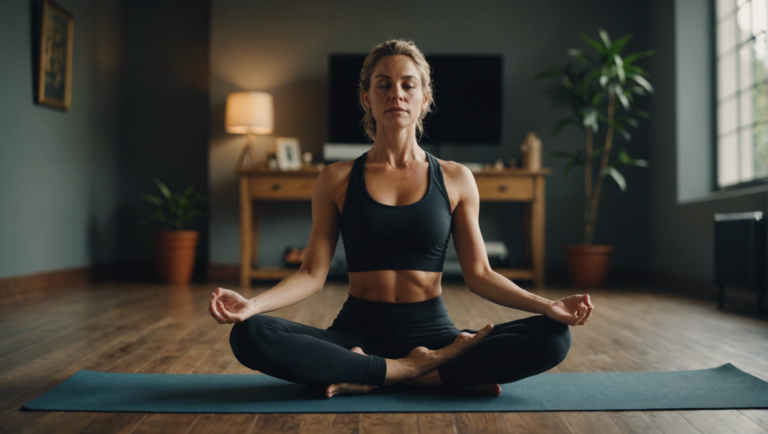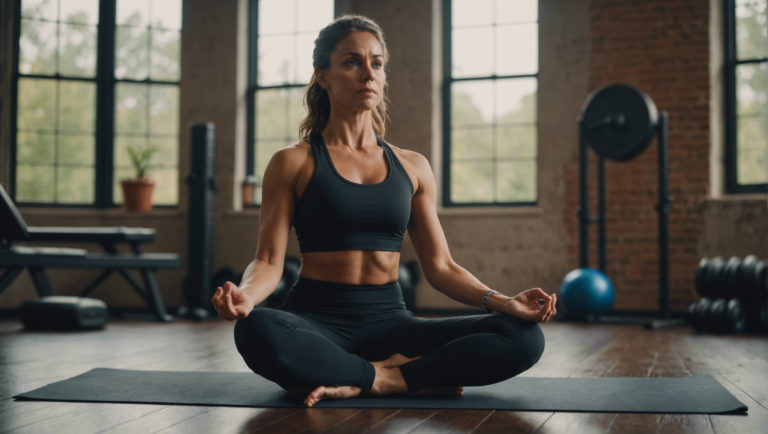Guidelines On How To Effectively Use A Yoga Wheel
The Benefits of Incorporating a Yoga Wheel into Your Practice
The yoga wheel has become a popular tool in yoga practices due to its versatility and numerous benefits it offers to practitioners. Integrating a yoga wheel into your routine can help enhance your practice by providing support, stability, and deeper stretches. Let’s explore the advantages of incorporating a yoga wheel into your yoga sessions.
Improved Flexibility and Mobility
One of the key benefits of using a yoga wheel is improved flexibility and mobility. The wheel allows you to deepen your stretches, particularly in poses that target the back, chest, shoulders, and hip flexors. By using the wheel as a prop, you can access deeper variations of familiar poses, leading to increased flexibility over time.
Enhanced Strength Building
A yoga wheel into your practice can also aid in building strength, especially in the core, arms, and legs. When using the wheel for exercises such as planks, push-ups, and leg lifts, you engage multiple muscle groups simultaneously, resulting in a more dynamic and challenging workout.
Better Alignment and Posture
Using a yoga wheel can help improve your alignment and posture by providing support and assistance in various poses. Whether you are working on backbends, inversions, or seated stretches, the wheel can help you find the proper alignment and maintain it throughout the pose, reducing the risk of injuries and discomfort.
Increased Balance and Stability
Balancing on a yoga wheel requires focus, coordination, and core strength, which can help enhance your overall balance and stability. Practicing balancing poses on the wheel challenges your equilibrium and proprioception, leading to improved stability both on and off the mat.
Deep Tissue Massage and Release
Beyond traditional yoga poses, the yoga wheel can be used for deep tissue massage and myofascial release. By rolling the wheel along different muscle groups, you can target tight areas, release tension, and improve circulation. This self-massage technique can complement your yoga practice and aid in recovery after intense workouts.
Mind-Body Connection
Integrating a yoga wheel into your practice can also deepen your mind-body connection. As you explore new poses and movements with the wheel, you become more aware of your body and breath, fostering mindfulness and presence on the mat. The wheel serves as a tool to help you connect with your body on a deeper level.
Incorporating a yoga wheel into your yoga practice can offer a wide range of benefits, including improved flexibility, strength building, better alignment, increased balance, and enhanced mind-body connection. Whether you are a beginner or an experienced yogi, the yoga wheel can be a valuable prop to support your practice and take it to the next level. Experiment with different poses and exercises using the wheel to discover the transformative effects it can have on your overall well-being and yoga journey.
Different Yoga Wheel Exercises to Enhance Flexibility and Strength
Yoga wheels have become a popular prop in the practice of yoga due to their versatility in enhancing flexibility, strength, and balance. By incorporating a yoga wheel into your routine, you can take your practice to the next level and target different muscle groups effectively. In this article, we will explore various yoga wheel exercises that can help you improve your flexibility and build strength.
Benefits of Yoga Wheel Exercises
Yoga wheel exercises offer a wide range of benefits for practitioners of all levels. a yoga wheel into your practice can help you deepen your stretches, improve your posture, and strengthen your core muscles. The circular shape of the wheel allows for a greater range of motion, making it easier to access areas of the body that are typically hard to reach. Additionally, using a yoga wheel can help release tension in the muscles, promoting relaxation and reducing stress.
Cat-Cow Stretch
The Cat-Cow stretch is a classic yoga pose that can be enhanced with the use of a yoga wheel. Start by sitting on your knees with the yoga wheel in front of you. Place your hands on the wheel and slowly roll it away from you as you lower your chest towards the floor, arching your back like a cow. Then, reverse the movement by pulling the wheel towards you while rounding your back like a cat. This exercise helps improve spinal flexibility and opens up the chest and shoulders.
Hip Opener Stretch
To perform a hip opener stretch using the yoga wheel, sit on the floor with your knees bent and feet flat on the ground. Place the yoga wheel behind you and lean back, resting your upper back on the wheel. Extend your arms out to the sides for balance and allow your hips to sink towards the floor. This deep stretch targets the hip flexors and quadriceps, helping to increase hip mobility and alleviate tightness in the lower body.
Wheel-Assisted Downward Dog
Downward Dog is a popular yoga pose that can be intensified with the addition of a yoga wheel. Start in a tabletop position with the wheel in front of you. Place your hands on the wheel and lift your hips up and back into Downward Dog position. The wheel allows for a deeper stretch in the shoulders and hamstrings while also engaging the core muscles for stability. Hold the pose for a few breaths before gently releasing.
Seated Forward Fold
Using the yoga wheel for a seated forward fold can help improve hamstring flexibility and release tension in the spine. Sit on the floor with your legs extended in front of you and place the wheel over your feet. Hold onto the sides of the wheel as you hinge at the hips and fold forward, keeping your back flat. The wheel provides support and encourages a deeper stretch in the hamstrings and lower back.
Yoga wheel exercises into your practice can offer numerous benefits for both the body and mind. By exploring different poses and stretches with the yoga wheel, you can enhance your flexibility, build strength, and deepen your yoga practice. Whether you are a beginner or an experienced yogi, the yoga wheel can be a valuable tool in taking your practice to new heights.
Tips for Beginners on Using a Yoga Wheel Safely and Effectively
Using a yoga wheel can be a fantastic way to enhance your yoga practice by deepening stretches, improving flexibility, and building core strength. For beginners, it is essential to familiarize yourself with the proper techniques to use a yoga wheel safely and effectively to prevent injuries and maximize the benefits it offers.
Understanding the Yoga Wheel
Before diving into using a yoga wheel, it’s crucial to understand what it is and how it can benefit your practice. A yoga wheel is a circular prop made of plastic, wood, or metal, typically covered with a layer of padding. It helps improve flexibility, release tension, and support various yoga poses by providing stability and control.
Choosing the Right Wheel
When selecting a yoga wheel, opt for one that is sturdy, durable, and the right size for your body. Beginners may find it more comfortable to start with a wider wheel for added stability. Ensure that the padding is thick enough to provide cushioning and support during poses.
Warm-Up Before Using the Wheel
Before incorporating the yoga wheel into your practice, it’s essential to warm up your body to prevent strains or injuries. Perform some gentle stretches or yoga poses to prepare your muscles for the movements you will be doing with the wheel.
Start Slow and Focus on Alignment
Beginners should start slowly and focus on proper alignment when using the yoga wheel. Pay attention to how your body feels in each pose and make adjustments as needed to avoid discomfort or strain. Engage your core muscles to support your spine and protect your lower back.
Incorporate the Wheel into Your Practice
There are many ways to use a yoga wheel to enhance your practice. You can use it to deepen backbends, improve balance in standing poses, or increase stability in inversions. Experiment with different poses and techniques to discover how the wheel can support your practice.
Listen to Your Body
As you explore using the yoga wheel, remember to listen to your body and honor its limits. Avoid pushing yourself into poses that feel painful or uncomfortable. The wheel should enhance your practice, not cause strain or injury.
Seek Guidance from a Qualified Instructor
If you’re new to using a yoga wheel or have specific concerns, consider seeking guidance from a qualified yoga instructor. They can provide personalized tips and modifications based on your individual needs and help you use the wheel safely and effectively.
Using a yoga wheel can add a new dimension to your yoga practice, allowing you to deepen stretches, improve flexibility, and strengthen your body. By following these guidelines for beginners, you can use the yoga wheel safely and effectively to enhance your practice and experience the benefits it has to offer. Remember to start slowly, focus on alignment, and listen to your body to make the most of this versatile yoga prop.
Exploring Advanced Yoga Wheel Techniques for Experienced Practitioners
Advanced yoga practitioners looking to deepen their practice often turn to yoga props to enhance their poses and explore new possibilities. One such versatile prop gaining popularity in the yoga community is the yoga wheel. While beginners may use the yoga wheel for basic stretches and gentle backbends, experienced practitioners can take their practice to the next level by incorporating advanced techniques. In this article, we will explore some advanced yoga wheel techniques that seasoned yogis can integrate into their practice to improve flexibility, strength, and balance.
Developing Core Strength with Challenging Poses
Advanced practitioners can use the yoga wheel to target and strengthen their core muscles. One challenging technique is the "Hollow-Back Handstand" where the practitioner begins in a forearm stand position with the legs extended upwards against a wall. Placing the yoga wheel under the legs and slowly rolling it towards the head can intensify the core engagement required to maintain balance. This pose not only enhances core strength but also improves shoulder stability and overall body awareness.
Enhancing Backbends and Spinal Flexibility
For experienced yogis looking to deepen their backbends, the yoga wheel can provide excellent support and extension. A dynamic technique involves starting in a reclined position with the yoga wheel positioned under the mid-back. Pushing into the feet, hands, and wheel, the practitioner lifts their hips towards the ceiling, creating an intense backbend. This advanced backbend helps open the chest, stretch the shoulders, and increase spinal flexibility. Remember to engage the core muscles and breathe deeply to release any tension in the spine.
Improving Balance and Inversion Practice
Advanced inversion practitioners can challenge themselves by incorporating the yoga wheel into their handstand or forearm stand practice. Placing the hands on the sides of the wheel while kicking up into a handstand can add an element of instability, requiring greater balance and core control. Practicing inversions with the yoga wheel not only strengthens the arms and shoulders but also improves proprioception and body alignment. Remember to practice these poses against a wall or with a spotter for safety.
Stretching and Strengthening Leg Muscles
Yogis looking to target their leg muscles can benefit from using the yoga wheel in standing poses and stretches. One advanced technique involves standing on one leg while holding the yoga wheel overhead. By slowly lowering the wheel towards the floor while maintaining balance, practitioners can engage the quadriceps, hamstrings, and calf muscles. This technique challenges both strength and flexibility in the legs while improving overall stability and focus.
Advanced yoga practitioners can elevate their practice by incorporating the yoga wheel into their routine. From developing core strength and enhancing backbends to improving balance and leg strength, the yoga wheel offers endless opportunities for exploration and growth. Remember to practice mindfully, listen to your body, and seek guidance from a qualified yoga instructor when attempting advanced techniques with the yoga wheel. Embrace the journey of self-discovery and transformation as you advance in your yoga practice with the innovative and versatile yoga wheel.



